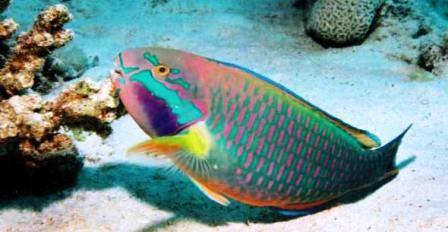Home › Sea Life › Marine Creatures › Vertebrates › Parrotfishes › Queen Parrotfish
Interesting Facts about the Queen Parrotfish
[Phylum: Chordata] [Class: Actinopterygii] [Order: Labriformes] [Tribe: Scarini] [Species: S. vetula]
There are nearly one hundred different species of parrotfish, but the vivid colouration of blues, greens, and yellow is the main reason why the queen stands out from the crowd.
This page contains information about queen parrotfish (Scarus vetula), including where they thrive best, what they eat, and how these colourful marine ray-finned fish reproduce.
Queen Parrotfish Distribution and Habitats
Most parrotfishes live near sandy coral reefs in tropical and subtropical oceans. But, the best areas to find queen parrotfish are:
- The Western Atlantic Ocean (e.g. Florida, the Bahamas, Brazil)
- Gulf of Mexico
- The Caribbean Sea
You can also find some species living in shallow coastal regions where there are seagrass beds and rocky substrates.
In fact, parrot fish get shelter and food from coral reef formations. The feeding behaviour and "scraping action" of these "ecosystem engineers" (known as "bioerosion") helps to prevent excessive algae growth and maintain healthy reefs.
Pro Tip: This erosive action and the distribution of coral sands in marine biomes is only possible because of some special parrotfish adaptations in their dentition (the arrangement and structure of teeth).
Queen Parrotfish Characteristics
The body shape of most parrotfish species is fusiform (e.g. elongated and laterally compressed). The head is quite rounded and they have large fish scales.
The standard vibrant colourings of blues, yellows, purples, and greens can change according to their age, gender, and their social status on any given day.
But wait - there's more:
Queen parrotfish can secrete a mucus cocoon - often called a "sleeping bag". Thus, excreting a protective mucus membrane from their mouth completely shrouds the fish before it goes to sleep.
The main reason is to evade their main predators, including lemon sharks and moray eels. The skin also contains an antioxidant substance which helps the fish repel parasites and repair damaged body parts.
Adult queen parrotfish (Scarus vetula) inhabit deeper reefs - down to 25 metres. They can grow to around sixty (60) centimetres long (24 inches) and weigh around twenty (20) kilograms (45 pounds).
Pro Tip: The females and juveniles tend to display lighter body colours (e.g. reddish brown) and they prefer to live in shallower environments where there is a better supply of natural protection.
What Do Queen Parrotfish Eat?
The diet can vary slightly according to the different kinds of parrot fish. But, queen parrotfishes are herbivores that consume copious amounts of algae.
 Apart from grazing on algae and coral reef polyps, their daily intake can also include:
Apart from grazing on algae and coral reef polyps, their daily intake can also include:
- Planktonic organisms and zooplankton
- Seagrass
- Sea sponges
- Small marine invertebrates and other microorganisms, including sand (ingested as they feed and graze on coral and rock)
Parrot fish are known for excreting ground-up coral as fine sand. In turn, this type of bioerosion (the removal of calcium carbonate substrate) contributes to the formation of healthy coral reef habitats and soft sandy beaches.
How Do Queen Parrotfish Reproduce?
The mating strategy takes place through external fertilisation. Thus, males and females "simultaneously" release eggs and sperm into the water column.
Spawning usually takes place in the early mornings or late afternoons. Any fertilised eggs will drift with planktonic material in the prevailing currents until they hatch into free-swimming larvae.
It can take several weeks for queen parrotfish larvae to settle on coral reefs and start growing into juveniles. Even so, the process increases their genetic diversity and it also means they can adjust their sex ratios (often based on populations and environmental conditions).
Threats and Predators
The queen parrotfish has a number of natural predators in the wild, such as reef sharks (especially lemon sharks), moray eels, barracudas, and other large fish species (e.g. groupers and snappers).
In addition to that, some of the human-induced threats that threaten their long-term survival include:
- Climate change (resulting in varying degrees of coral bleaching).
- Illegal fishing practices (e.g. spearfishing) and overfishing.
- Underwater garbage pollution.
- Habitat degradation and destruction (including habitat loss from dynamite fishing).
Pro Tip: The IUCN Red List of Threatened Species assessed the current status of the queen parrotfish (Scarus vetula) as "Least Concern" (LC).